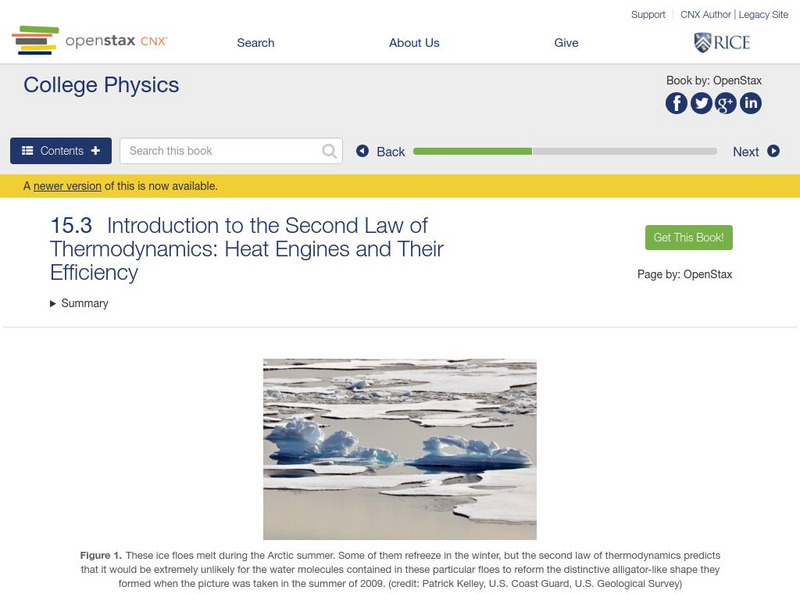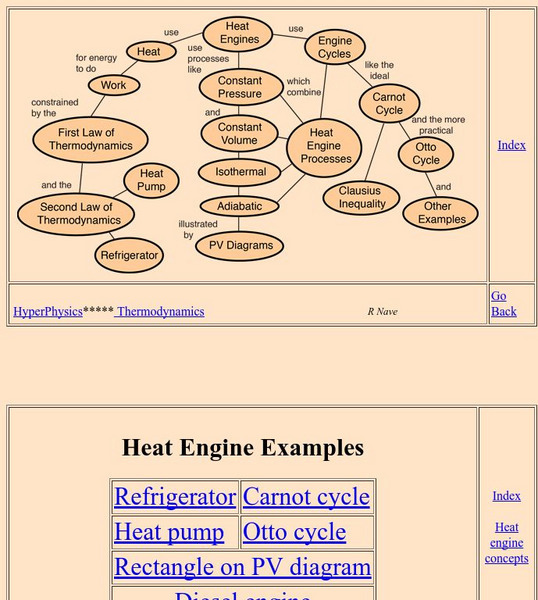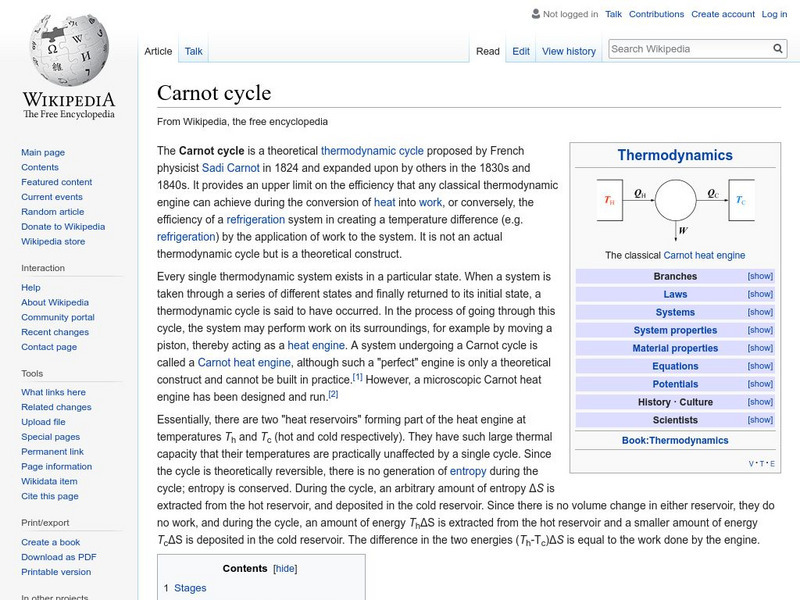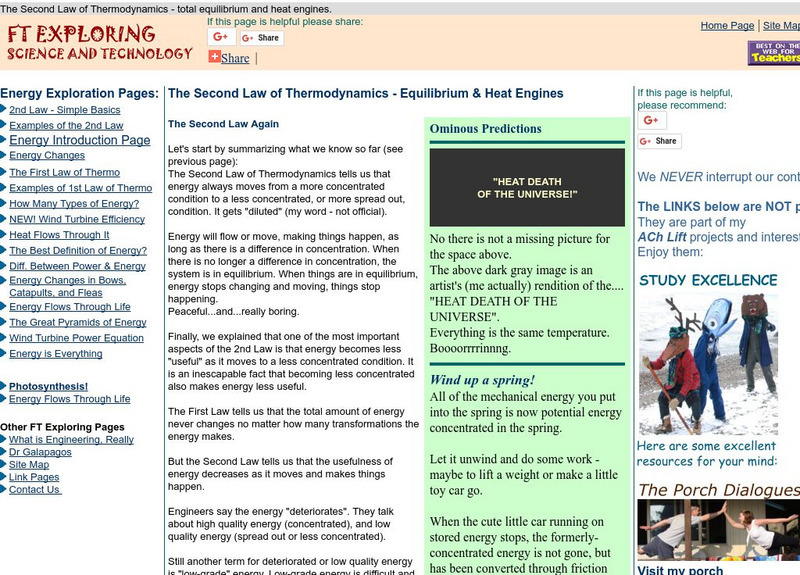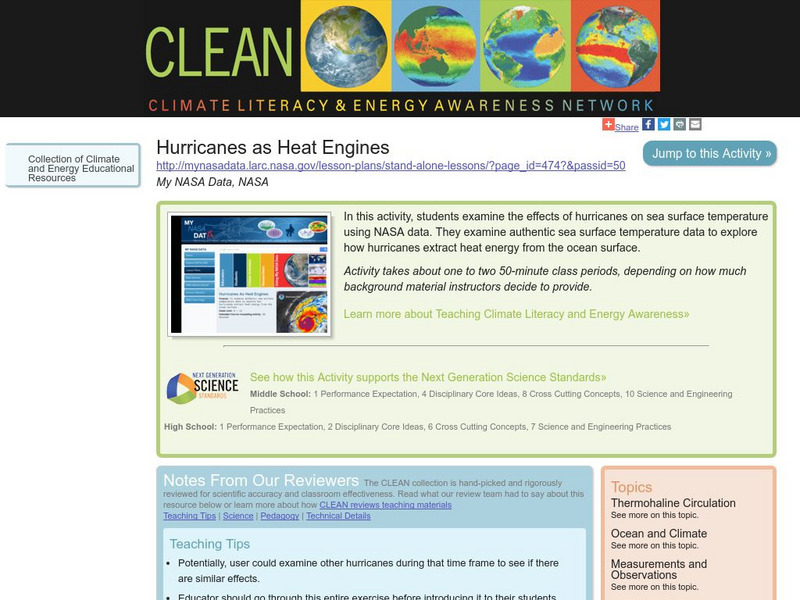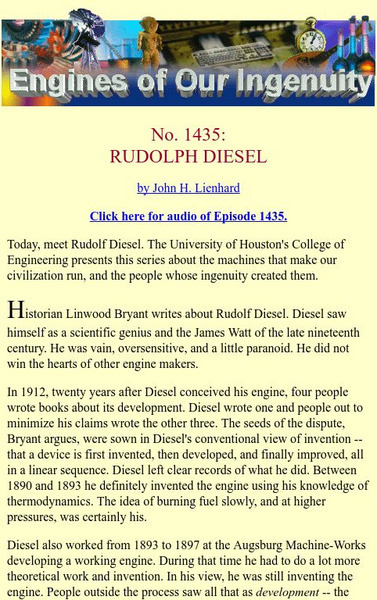Hi, what do you want to do?
Curated OER
Inventions 2: The Impact
Students research inventors and inventions and their impacts. In this invention instructional activity, students research inventions and their affects in good and bad ways.
Curated OER
Beginning Analogies
In this analogies worksheet, students read the pairs of words and choose the answer that best expresses a relationship similar to the original pair. Students complete 12 examples.
CK-12 Foundation
Ck 12 Exploration Series: Simulations: Physics: Heat Engine
[Free Registration/Login Required] Having trouble understanding the energy transfer in heat engines? This simulation allows students to learn about the conversion of heat energy to mechanical energy in the context of heat engine.
OpenStax
Open Stax: Second Law of Thermodynamics: Heat Engines and Their Efficiency
In this section of the textbook, learn about the second law of thermodynamics and how it relates to the function of heat engine. Section will also explain how to calculate net work and efficiency of cyclical processes such as a heat...
CK-12 Foundation
Ck 12: Heat Engine
[Free Registration/Login may be required to access all resource tools.] Students will learn about heat engines, explore pressure volume diagrams, and figure how to calculate ideal efficiencies of heat engines.
Simon Fraser University
Chem1 Virtual Textbook: What Is a Heat Engine and Why Should You Care?
With an overview of topics related to chemical equilibrium, this site provides a foundation to a study of thermodynamics and heat engines. Other topics covered include the fall of heat, nuclear plants, and more.
Georgia State University
Georgia State University: Hyper Physics: Heat Engine Cycle
The heat engine cycle is defined and discussed. So pressure-volume diagrams are introduced and their use in depicting the cycles of a heat engine is demonstrated. Informative graphics are accompanied by reason-filled explanations.
Georgia State University
Georgia State University: Hyper Physics: Heat Engine Concepts
An indexing page for the HyperPhysics site. The page contains a concept map of links to a variety of other pages which discuss concepts related to heat engines. All pages contain informative graphics and excellent explanations.
Wikimedia
Wikipedia: Carnot Heat Engine
Wikipedia offers information on the Carnot heat engine that uses a particular thermodynamic cycle developed by Nicolas Carnot in 1820.
FT Exploring
Ft Exploring: The Second Law of Thermodynamics Equilibrium & Heat Engines
Use this illustrated guide to understand equilibrium and heat engines as they relate to the second law of thermodynamics.
Georgia State University
Georgia State University: Hyper Physics: Heat Engine Concepts: The Otto Cycle
Schematic diagrams illustrating the operation of a four-stroke engine cycle. Interactive buttons allow you to step through the various steps of each engine cycle. Each graphic is accompanied by an excellent explanation.
Georgia State University
Georgia State University: Hyper Physics: Heat Engine Concepts: Carnot Cycle
The Carnot cycle is described, illustrated and explained. The Carnot efficiency equation is given and interactive JavaScript form allows the visitor to investigate the effect of the reservoir temperature and the sink temperature upon the...
Texas Education Agency
Texas Gateway: Second Law of Thermodynamics: Heat Engines and Their Efficiency
By the end of this section, you will be able to state the expressions of the second law of thermodynamics; calculate the efficiency and carbon dioxide emission of a coal-fired electricity plant, using second law characteristics; and...
Colorado State University
Csu Internal Combustion Engines
Dr. Allan T. Kirkpatrick of Colorado State University presents extensive detailed information on thermodynamics, heat transfer in engines, and fluid mechanics.
University of Sydney (Australia)
Thermal Physics Module: Heat Engines [Pdf]
The second law of thermodynamics and the concept of entropy is applied to the topic of heat engines. The Carnot and Stirling engine are discussed. Efficiency is explained and an equation is derived.
Other
Applied Thermodynamics: Heat Engines
Forward and reverse heat engines are discussed and explained at this site from Applied Thermodynamics. Diagrams are provided. Efficiency equations are given and discussed.
Climate Literacy
Clean: Hurricanes as Heat Engines
In this activity, students examine the effects of hurricanes on sea surface temperature using NASA data. They examine authentic sea surface temperature data to explore how hurricanes extract heat energy from the ocean surface.
Texas Education Agency
Texas Gateway: Applications of Thermodynamics: Heat Pumps and Refrigerators
By the end of this section, you will be able to describe the use of heat engines in heat pumps and refrigerators, demonstrate how a heat pump works to warm an interior space, explain the differences between heat pumps and refrigerators,...
Science Buddies
Science Buddies: Project Ideas: Transferring Heat by Convection in a Tank
In this engineering science fair project, students will determine the most effective method for quickly raising the temperature of a liquid in a tank. The Science Buddies project ideas are set up consistently beginning with an abstract,...
Exploratorium
Exploratorium: Science Snacks: Hand Held Heat Engine
Can you defy the force of gravity by making liquid in a toy rise and fall without turning it over? This experiment will show you how to use hand boiler that uses temperature and pressure to move liquid into the top chamber.
University of Houston
University of Houston: Engines of Our Ingenuity: Rudolf Diesel
An interesting account of Rudolf Diesel and his invention of the diesel engine. The text is the actual transcript of a syndicated radio broadcast called "Engines of Ingenuity." Outstanding information on Diesel and his engine invention.
Georgia State University
Georgia State University: Hyper Physics: Heat Pump
Heat flow from a hot region to a cold region is described and explained. Applications of this phenomenon (specifically heat pumps and refrigerators) are discussed. Excellent graphics.
Physics Aviary
Physics Aviary: Practice Problems: Efficiency of an Engine
Determine the efficiency of an engine (0 - 1) based on the energy flow that is presented to you.
Georgia State University
Georgia State University: Hyper Physics: Heat of Fusion
The heat of fusion is defined and described. A graphical representation of the heat of vaporization is given. A method for measuring and calculating the heat of fusion is also presented and explained.








